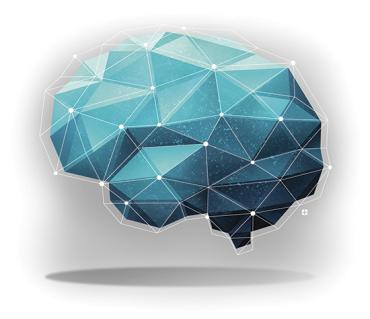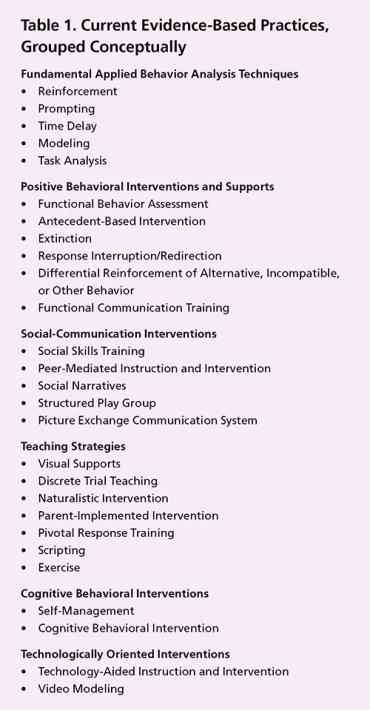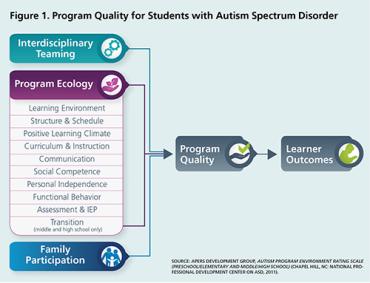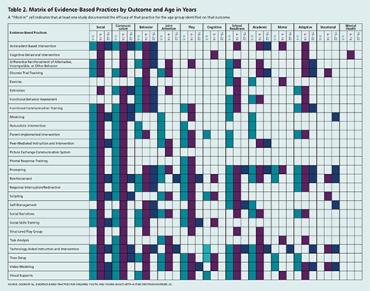Victor is a junior at Singleton High School in a Midwestern city, and he has autism spectrum disorder (ASD). In his chemistry class, which he attends with students who do not have special needs, the lesson for the day is on endothermic reactions. The teacher has organized the class into small groups of four to review the lab experiment that they will do later in the period. Victor, a tall, rangy young man with sandy blond hair, reads the lab sheet and listens to his classmates, while rocking slightly in his chair. The teacher has modified Victor’s worksheet to help him follow the lesson. After this review, the teacher directs the students to move to their lab space and work with their groups to conduct the experiment.
At the lab space, Sarah, a member of Victor’s group, has been assigned to work with Victor today. Victor starts the lesson by reviewing and following the instructions, with Sarah’s occasional reminders. His rocking increases as they begin the experiment. Eventually, he leaves the experiment to pace the room, periodically returning to check on the progress and complete some of the steps of the lesson with Sarah. The teacher and his classmates know that Victor feels anxious in social situations and has a hard time concentrating on tasks for a long period of time. His pacing does not draw a single glance from his peers.
When the lab experiment ends, Victor helps put the equipment away in the appropriate locations, which are clearly labeled. He and his classmates return to their small groups and complete the worksheets for their experiment. Then the bell rings, and they head to their next class. When asked later about Victor’s work, the chemistry teacher says he’s a solid B student.
Victor’s mother says that her goal is for her son to attend community college and graduate from a university. Victor says he wants to be a scientist like his mom.
Rosa is a fourth-grader, also with ASD, who attends Monte Verde Elementary School in a Southern California city. Her parents emigrated from Mexico before she was born. Rosa has a hard time using words to communicate with others and is learning to use a communication program on an iPad. The program enables her to touch a small picture on the screen to generate a voice that expresses her thoughts, such as “hello,” “all through,” “how are you today?” or “I need a break.”
Much of Rosa’s day is spent in a special education class with five other children, four of whom have ASD. The class is very structured; there are well-labeled areas designated for specific activities (e.g., group academics, independent work, literacy, computer work). The schedule is posted on the whiteboard, but Rosa also has her individual schedule with small symbols that represent the sequence of activities for the day (e.g., a symbol of a small book indicates literacy time).
During part of the day, Rosa and her teacher work together focusing on her individual goals; at other times, she participates in small learning groups or works on independent learning tasks the teacher has designed. At two points during the day, as well as during lunch and physical education, Rosa joins a fourth-grade class down the hall.
While her teacher acknowledges the challenges Rosa faces, such as living in a bilingual community and being nonverbal, she takes pride in her successes: Rosa is mostly independent in class, is starting to have an interest in communicating with others, and has made gains in her early literacy lessons. Rosa’s parents hope their daughter eventually will be able to attend middle school with the children from their neighborhood.
Victor and Rosa, whose names we have changed (as well as the names of their schools) to protect their privacy, illustrate the complexities and challenges confronting children and youth with ASD. In the last 10 years, the prevalence of ASD has increased 200 percent.1 Principals, special education directors, and superintendents across the country report that their schools are teaching increasing numbers of students with ASD. We have found that educators want to provide a good and effective educational experience, but they may not be sure where to start or what to do. ASD is not usually a part of their preservice training, and while laws such as the Individuals with Disabilities Education Act dictate that they must use research-based practices, most resources are difficult to find and confusing to implement.
In this article, we discuss the evidence-based practices (EBPs) that are solidly supported by the research. We also provide sources for learning more about how to use EBPs in school, community, and home settings. And we discuss the types of training that can lead to their effective use by teachers. But first, we begin with a short description of ASD.
What Is Autism Spectrum Disorder?
Although several psychiatrists in the early 20th century used the term “autism” to describe their clients, it was the work of two psychiatrists in the 1940s that has had the most important contemporary impact on diagnosis. In 1943, Leo Kanner, a child psychiatrist at Johns Hopkins University in Baltimore, reported a unique pattern of social withdrawal, rigidity in behaviors (e.g., becoming extremely upset over a tiny change in schedule or environment), and echolalia (repeating words or phrases that others have just said). Because of its extreme social isolation, he used the term “autism” (a Greek derivative that means extremely self-aware) to describe the condition. Around the same time (1944), Hans Asperger, a psychiatrist in Austria, saw a similar pattern of social difficulties among young men who were his patients and described the condition as “autism.” “Asperger’s syndrome” became a term often used to describe, and even diagnose, children with autism who did not also have intellectual disabilities. As diagnostic classification systems evolved, both “autistic disorder” and Asperger’s syndrome, in the United States, were combined into a single classification: autism spectrum disorder.
ASD is known as a “spectrum” because of a common set of characteristics—such as onset before age 3, difficulties in social communication, and restricted and repetitive behaviors—and the wide range in the way these characteristics are expressed. For instance, Victor would talk with his teachers and classmates but often not look them in the eye, and his speech didn’t have the same cadence as the speech of his teenage classmates. Although he would talk with his peers, he often preferred to be alone. Rosa, on the other hand, did not use words to communicate with her teachers or peers and was learning to use the iPad communication system. Her teacher tried to stick to a standard schedule because Rosa found schedule changes very upsetting and confusing.
Both Victor and Rosa have different forms of what scientists call repetitive or stereotypic behavior: unusual physical movements such as rocking (Victor) or flicking fingers in front of one’s eyes (Rosa). ASD is also characterized by co-occurring conditions. Rosa has an intellectual disability, which occurs in 40–60 percent of individuals with ASD.2 Victor experiences social anxiety that sometimes leads to “meltdowns” (i.e., nondirected tantrums).
Although ASD occurs most often in boys (more than 75 percent of the time),3 it also occurs in girls, as in Rosa’s case. Over the last 40 years, the rate of autism diagnoses has increased dramatically: In the 1970s, it was estimated at 4 in 10,000 people.4 Recently, the Centers for Disease Control and Prevention reported that ASD occurs in 1 in 68 children.5 Scientists think that this increase has been due to greater public and professional awareness of ASD, as well as changes in diagnostic criteria and assessment practices.6 ASD crosses ethnic and racial lines equally, although children from African American and Latino families tend to be diagnosed at older ages.7
Shrouded in Myth
Probably more than any other disability, autism has been shrouded in myth and plagued by misinformation. During the early history of ASD, scientists attributed the cause to mothers having an emotionally cold relationship with their children. They were called “refrigerator mothers,” and the treatment entailed removing the child from the home. Current genetics and neuroscience have debunked that myth. A second myth, based on fallacious medical research, was that measles, mumps, and rubella (MMR) vaccinations caused autism in some children. That myth has also been scientifically disproven, but its persistence has led some parents to refuse vaccinations for their children, which in turn has contributed to the re-emergence of measles in this country.
Likewise, many proponents of ASD treatments make claims from cure or recovery to amelioration, but they can point to little scientific evidence of effectiveness. These interventions appear in books and on websites that proclaim them as “cutting-edge therapies” for autism. Sometimes they even mix in programs and practices that do have research evidence to support their use, thus lending them an air of legitimacy and further confusing consumers. Educators and family members need to have a reliable source for finding out about practices that have been shown, through research, to be effective with children and youth with ASD.
Our Search for Evidence-Based Practices
In 2006, the U.S. Department of Education funded the National Professional Development Center on Autism Spectrum Disorder (NPDC), with the explicit goal of promoting educators’ use of evidence-based practices for children and youth with ASD (from birth to 22 years—that is, from early intervention to the transition-to-community years of schooling).* An immediate dilemma presented itself. Although researchers had talked and written about evidence-based practices, there had never been a published comprehensive, critically reviewed summary of them.
To begin the work of the NPDC, we first conducted a review of the literature.8 During the first year, NPDC investigators did an extensive search of research published between 1997 and 2007. They used professional standards for evaluating methods of published studies,9 identified focused intervention practices that researchers used, and then grouped those interventions into categories of evidence-based practices. A total of 24 practices were identified, and we published a report of this review.10 We then collaborated with the Ohio Center for Autism and Low Incidence to develop online training modules for each of these practices.†
The research on focused intervention practices for children and youth with ASD does not stand still; in fact, it moves quickly. In 2010, we realized that we would have to continually update the literature review. New research had been published since 2007 that could provide further evidence for practices previously identified. Also, we knew that new research had been completed that would potentially qualify new practices as evidence-based. In addition, we thought we could improve on the review methods we had previously used.
In this second literature review, we included research published from 1990 to 2011. Our initial broad search yielded more than 29,000 articles. We screened and eliminated many of them, and reduced the number of articles that met our inclusion criteria (i.e., they were based on research that included participants with ASD who were school-aged and that used experimental methodology) to around 1,100. Those were further reviewed by a national group of professionals who had training in research methods and experience with ASD to identify the ones whose methodology met the standards for high-quality research. From that review, we further narrowed the literature to 546 articles. Members of our central research team conducted a systematic content analysis of practices in these research articles, finding 27 distinct evidence-based practices that met our criteria. We have listed those practices in Table 1 below. (For a full description of our methodology, see the technical report published online.)11
These 27 evidence-based practices are techniques that educators can use to promote the development and learning of children and youth with ASD; we describe these below and then walk through a process for appropriate practice selection.
Fundamental Applied Behavior Analysis Techniques
A common mistake in the field is to think of applied behavior analysis techniques as one practice. In fact, many practices are based conceptually on applied behavior analysis theory, and they are considered among the most effective approaches for children and youth with ASD. We identified five practices that we call “fundamental” because they reflect the basic principles of applied behavior analysis. Fundamental applied behavior analysis practices (italicized below as we unpack them) can be used by teachers, speech pathologists, school psychologists, paraprofessionals, and family members as individual interventions or as part of multicomponent EPB strategies. In other words, they are the building blocks for some of the other intervention approaches.
Reinforcement is a technique in which educators apply a consequence, such as descriptive praise, a grade, or an item (e.g., a sticker), after a child engages in a desired behavior, in order to increase the reoccurrence of the behavior in the future. The educator may assist the child in engaging in the behavior by providing a prompt (e.g., an instruction, a gesture, a helping hand).
A particular problem for some children with ASD is that they become dependent on prompts from adults to engage in a learned skill. A strategy for “weaning” students from this support is called time delay. For example, the educator might set up the occasion for Rosa to ask for materials using her iPad by putting out all the materials for an art activity except the scissors. The educator would wait for a brief time with an expectant look on her face (e.g., 5–10 seconds) to allow Rosa to ask for the scissors on her own. The educator would prompt Rosa if she does not ask for the scissors during the time delay.
Educators may show a student how to engage in a behavior or action by modeling that behavior (e.g., a teacher shows a student how to put away materials used in an activity in their labeled locations). Another basic behavior strategy called task analysis involves breaking down complicated behaviors or tasks into smaller parts. For example, a teacher might identify the six steps needed for Victor to make the transition from his last class of the day to the bus he will be taking home. The teacher would then specifically teach Victor each step so he can reach his goal of independent transitioning from school to home. As noted, these fundamental behavioral techniques are often used in combination with other techniques in the evidence-based practices we describe next.
Positive Behavioral Interventions and Supports
The practices we discuss in this article are designed to teach students a skill in which they need to be proficient (e.g., interacting socially with peers). However, students with ASD may engage in behaviors that are undesirable and distract from learning, which we will call problem behaviors. These behaviors may be repetitive in nature, such as rocking or unusual hand or motor movements, tantrums or “meltdowns,” or repetitive vocalizations. A general strategy for addressing these behaviors is called Positive Behavioral Interventions and Supports (PBIS), and many schools have adopted it schoolwide to address problem behaviors for all students. In our review of the ASD intervention literature, we identified many of the individual interventions that make up the system of PBIS.
When a problem behavior occurs, an initial approach is to try to determine the cause of the behavior through a functional behavior assessment. By observing and recording what happens immediately before and after a problem behavior occurs, educators may be able to determine the cause. In some cases, a situation may trigger a behavior, like too much noise in a certain part of the classroom. The teacher may use an antecedent-based intervention in which he or she removes the trigger, in this case moving the student to a quieter part of the classroom. In other cases, the teacher may determine that when he or she attends to the student (e.g., by saying “stop that”) after each problem behavior, the attention actually appears to motivate the student to continue the behavior. In such cases, the teacher might use a practice called extinction, in which he or she ceases to give the student the desired attention by ignoring the behavior.
Sometimes a problem behavior will escalate from small, less intense occurrences (e.g., mild rocking) to a full-blown tantrum. An educator may see these early signs and use response interruption/redirection. For example, participating in a small-group activity increased Victor’s social anxiety, which first would manifest as rocking behavior but then would escalate to a meltdown if unaddressed. When the early stages of this “behavioral chain” began, the teacher would ask Victor to engage in a solitary activity (e.g., completing a worksheet) so he could settle down and return to the small-group activity.
Another strategy is to promote an appropriate behavior that would take the place of or be incompatible with the problem behavior. Using this differential reinforcement, the teacher provides positive reinforcements to a student for using a pencil to complete a class assignment instead of engaging in the tic of “finger flipping” with the pencil. When the problem behavior appears to result from frustration in not being able to communicate, an educator may use functional communication training. With this approach, the educator teaches communication skills to take the place of a problem behavior (e.g., a student is taught to use words to ask for a food item at snack time rather than crying and pointing at the food).
Social-Communication Interventions
A core feature of ASD is difficulty with social communication skills, the focus of several evidence-based practices. In one strategy, social skills are taught directly through social skills training, usually delivered in small-group settings based on a specific curriculum or therapy. A strategy that educators use in many schools is peer-mediated instruction and intervention, which may include teaching a peer to provide tutoring or support for a student with ASD (e.g., Sarah helping Victor in chemistry class). Such a strategy may also consist of establishing a peer social network that helps students with ASD engage in social interactions and relationships.
Another approach is social narratives,‡ in which a teacher or student writes a brief story about a social situation that explains the situation and perhaps how the student should act in the situation. For Victor, his teacher writes a narrative describing the appropriate way of joining a group of peers having lunch in the cafeteria. Victor would read the story before going to lunch, and the teacher would review the story with him; later that day, the teacher would discuss with Victor what happened at lunchtime. For children with ASD, structured play groups can be arranged by the teacher in ways that support the social and play interactions of the student with ASD and the student’s peers.
One of the most frequently used interventions to promote communication skills for nonverbal students with ASD is the Picture Exchange Communication System. This system begins with having students exchange pictures for desired objects and then prompting them, once they are ready, to engage in verbal communication.
Teaching Strategies
Seven types of interventions focus on teaching a wide range of skills. Because many children and youth with ASD understand visual presentations of information, teachers frequently employ visual supports. These can include a schedule that highlights the order of the day’s activities in graphic symbols (like Rosa used), symbols posted in the class that provide cues for which activities should occur in which areas, and/or highlighted parts of a class activity that cue a response (e.g., a visual indicator that prompts students to write their names on class assignments).
Another teaching strategy is discrete trial teaching, which usually involves a teacher working one-to-one with a student with ASD. In this approach, the teacher provides prompts when necessary, reinforces correct responses, and corrects errors if they occur. Discrete trial teaching requires that the teacher provide many opportunities for the child to respond in the learning activities, which is sometimes called “massed trials.”
In contrast are naturalistic interventions, where the educator identifies activities and routines during a school day that give a child the opportunity to practice a skill. The teacher sets up the student’s schedule and activities to provide the learning opportunity, and then offers support through prompting or reinforcement. For example, for Rosa, the teacher identifies a minimum of five times during the day that Rosa would use her iPad to communicate with peers or adults in the class. The teacher ensures each opportunity is provided, offers a prompt (or time-delay prompt) if Rosa does not use the iPad independently, and then ensures an appropriate response.
Some interventions are parent implemented. Educators teach parents to use intervention techniques with their children in the home or community. This intervention may include some of the other evidence-based practices described in this article. For example, parents may use naturalistic interventions to teach a social or play skill or a form of discrete trial teaching to teach a language concept.
Pivotal response training is a teaching strategy that uses both behavioral and naturalistic strategies. In this approach, the educator builds on student initiative and interests by providing choices, reinforcing attempts, practicing previously learned skills, and providing directly related consequences for correct responses. For example, if an educator is teaching the student to use words when making a request, the natural consequence would be for the student to receive what she is requesting rather than the teacher’s praise or an unrelated reward such as a sticker. For instance, if the student asks for crayons, she would get crayons and not simply hear her teacher say, “Nice job using your words.”
To help a child learn to participate in specific situations, educators have used a technique called scripting, in which they prepare a written description of the situation and behavioral expectations, and use the script to help the child practice repeatedly before engaging in the actual situation. This practice is different from social narratives in that the child is taught specifically what to say in a special situation, and then he or she practices the response. In social narratives, the story the child reads (or sees through symbols) describes the social situation and may serve as a reminder of the way he or she should act in the situation.
Another evidence-based practice that emerged in our latest review was exercise. Facilitating a student’s engagement in physical activities can promote appropriate behavior or reduce problem behaviors. For example, a student with ASD may grow more inattentive and engage in more problem behavior (e.g., finger flicking and rocking) as the school day progresses, to the point that it interferes with his or her participating in the literacy activities in his or her special education class. By planning an exercise period with aerobic physical activity before the literacy activity, the educator may help improve the student’s attention and decrease the problem behavior—outcomes reported in the research studies.
Cognitive Behavioral Interventions
Two focused interventions employ a combination of cognitive and behavioral approaches. Although conceptually similar to one another, the procedures are different, and educators and therapists have used them to address different goals. Self-management strategies teach students to recognize when they are engaging in the correct or desired behavior (e.g., a goal specified in the student’s individual education plan), and also enable them to monitor or record the behavior and/or reward themselves when performing a specific criterion correctly.
Cognitive behavioral interventions focus on the student learning to be aware of his own thoughts and emotions, to recognize negative thoughts or emotions, and to use strategies for changing his thinking and behavior.
Technologically Oriented Interventions
As the world has become a more technological place, a large variety of interventions for students with ASD now rely on technology.12 A general evidence-based practice called technology-aided instruction and intervention employs technology as its central supporting feature. The range of these interventions is broad and includes computer-assisted instruction, speech-generating devices, smartphones, and tablets, to name a few.
With video modeling, students watch a video demonstration (perhaps on an iPad or smartphone) of the correct way to perform a skill or behavior immediately before they will be in a situation where they should use that skill. The person modeling the behavior in the video may be the student or another person.
Selecting and Using Evidence-Based Practices in Schools
Identification of evidence-based practices is only a part of the process of designing effective programs for students with ASD. In our work, we have suggested a plan for building such a program that incorporates assessing program quality, goal development, selection of specific practices, support for implementation, and ongoing evaluation of outcomes.13
Building on Quality
When our research team works with schools to implement evidence-based practices for students with ASD, we begin by discussing program quality. By program quality, we mean the features of a school that appear in Figure 1 below. A high-quality program has coordination among school interdisciplinary team members, family involvement, and a range of other features, such as clear organization of schedules and class environments, a positive social climate, and instructional guidelines. Trying to implement EBPs that focus on a student’s goals in a school that is unable to fully support students with special needs is, in the worst cases, like the proverbial “rearranging the deck chairs on the Titanic.” Even when implemented well, the practices are not going to achieve the desired effects for the student because the foundation is not there.
(click image for larger view)
We have developed an instrument to assess the quality of school programs called the Autism Program Environment Rating Scale (APERS), which includes assessment of all the features of quality appearing in Figure 1. When working with schools, we complete an APERS review, share it with school staff, and note the areas of strength and the areas for improvement. The school staff members then develop a work plan for addressing the areas for improvement.
For example, in Victor’s school, there were many areas of strength, but the staff members were not working closely as a professional team, had poorly written transition plans, and could have done a better job at involving families. The team members in the school (several special education teachers and general education teachers, the speech therapist, and the transition coordinator) identified these as areas for school improvement and worked on each during the year.
Setting Goals
Observable and measurable goals for students with ASD are a critical “end” on which teachers must focus. Being clear about the skill or behavior we want the student to learn is essential. In our work with schools, we spend a lot of time with teachers to develop students’ goals.§
Selecting Evidence-Based Practices
A teacher may look at the list of EBPs in Table 1 (above) and say, “There are 27 practices here. Do I have to use every one of them? If not, how do I pick the right one to use for a particular student?” One of the originators of evidence-based medicine, Dr. David Sackett, noted that evidence-based practice is not a cookbook.14 Selection of practices depends on the identification of the scientifically validated practices and the professional judgment of the practitioner.
In our work with educators, we use a matrix (Table 2 below) that identifies the common outcomes generated by each practice, sorted by age. We ask the teacher to first determine the general outcome area of a goal and then find the practices that have generated positive outcomes in those areas.
(click image for larger view)
For Victor, one goal (broadly stated) was talking with classmates at lunchtime. Given this goal, his teacher would look at the matrix, which has outcomes on the top row and EBPs in the left column. Toward the top of the matrix is a row that indicates at which age range(s) the practice has been determined to be effective. Victor’s goal is social, and he is in high school (the 15–22 age group). The matrix reveals nine EBPs that have produced positive outcomes for participants who were Victor’s age. The teacher would then review the practices and use her professional judgment about which one(s) might work best for Victor. For example, she might decide on a peer-mediated intervention and a social narrative intervention, which we described earlier. The high school already has a peer-buddy program, so she arranges for the peers in the program to spend time with Victor during lunch. Also, as noted previously, the teacher creates a social narrative that Victor reads immediately beforehand.
Finding the Procedural Details about EBPs
Many educators do not have time to sift through research journals to learn the details of EBPs they can use with their students. To that end, our group, in collaboration with the Ohio Center for Autism and Low Incidence, has developed online modules for all of the 24 practices found in the first literature review mentioned previously. Also, we have created briefs that contain the content from the online modules in PDF format. The modules and briefs are available for free on our website. Each module and brief contains a description of an EBP, data collection forms, the specific articles that contain the scientific evidence of the practice, video examples (for some but not all), and a fidelity checklist (important in evaluating accurate use of the practice). We are currently revising the modules to include the information from the most recent review15 and are revising the current practices based on the latest research.
Selected EBP interventions may not work for every student. The autism spectrum is broad, and the individual characteristics and needs of students with ASD are diverse. EBPs are an important starting place for educators. However, after selecting an EBP to use with an individual student, it is critical that the educator collect data on an ongoing basis about student progress. If an educator is implementing the practice appropriately (as measured by the fidelity checklists) and the student does not make progress over a reasonable period of time (as shown by the student’s data), the educator should consider other EBPs that have generated positive outcomes in the student’s goal area (e.g., interacting socially with peers).
The increased prevalence of ASD and the interest in evidence-based practices are substantially intertwined. Increasingly, educators will teach students like Victor and Rosa. Fortunately, the EBP movement in education has provided the necessary tools for building effective programs for students with ASD. These practices alone, though, will not give them the supports they need. They must be combined with attention to program quality, targeted professional development, and educator judgment and expertise, the foundation for helping all students, not only those with ASD, succeed.
Samuel L. Odom directs the Frank Porter Graham Child Development Institute at the University of North Carolina at Chapel Hill, where he is a professor in the School of Education. He is also the principal investigator of the National Professional Development Center on Autism Spectrum Disorder and the Center on Secondary Education for Students with Autism Spectrum Disorder. Previously, he was a member of the National Research Council’s Committee on Educational Interventions for Children with Autism. Connie Wong is a research investigator at the Child Development Institute and serves as the principal investigator of the study Toddlers and Families Together: Addressing Early Core Features of Autism. This article is based on their report Evidence-Based Practices for Children, Youth, and Young Adults with Autism Spectrum Disorder (2014).
*The center was a collaboration of scientists and professional development experts at the Frank Porter Graham Child Development Institute at the University of North Carolina at Chapel Hill, the Waisman Center at the University of Wisconsin–Madison, and the MIND Institute at the University of California, Davis, School of Medicine. (back to the article)
†These modules can be accessed at here. (back to the article)
‡Carol Gray first popularized the Social Stories technique in 1991. Students receive explanations about how to act in everyday situations that children with autism may find confusing. For more about her work, visit her website. (back to the article)
§We also use a system called Goal Attainment Scaling to rate students’ progress on their goals. More information can be found here. (back to the article)
Endnotes
1. Jon Baio, “Prevalence of Autism Spectrum Disorder among Children Aged 8 Years—Autism and Developmental Disabilities Monitoring Network, 11 Sites, United States, 2010,” Morbidity and Mortality Weekly Report 63, no. SS-2 (March 28, 2014): 1–21.
2. Baio, “Prevalence of Autism”; and Elisabeth M. Dykens and Miriam Lense, “Intellectual Disabilities and Autism Spectrum Disorder: A Cautionary Note,” in Autism Spectrum Disorders, ed. David Amaral, Daniel Geschwind, and Geraldine Dawson (New York: Oxford University Press, 2011), 263–269.
3. Baio, “Prevalence of Autism.”
4. M. Rutter, “Incidence of Autism Spectrum Disorders: Changes Over Time and Their Meaning,” Acta Pædiatrica 94 (2005): 2–15.
5. Baio, “Prevalence of Autism.”
6. Alison Presmanes Hill, Katharine E. Zuckerman, and Eric Fombonne, “Epidemiology of Autism Spectrum Disorders,” in Handbook of Autism and Pervasive Developmental Disorders, 4th ed., vol. 1, Diagnosis, Development, and Brain Mechanisms, ed. Fred R. Volkmar, Rhea Paul, Sally J. Rogers, and Kevin A. Pelphrey (Hoboken, NJ: Wiley, 2014), 57–96.
7. The latest information on prevalence and other characteristics associated with ASD was published in a report from the Centers for Disease Control and Prevention. See Baio, “Prevalence of Autism.”
8. Samuel L. Odom, Lana Collet-Klingenberg, Sally J. Rogers, and Deborah D. Hatton, “Evidence-Based Practices in Interventions for Children and Youth with Autism Spectrum Disorders,” Preventing School Failure 54 (2010): 275–282.
9. Russell Gersten, Lynn S. Fuchs, Donald Compton, Michael Coyne, Charles Greenwood, and Mark S. Innocenti, “Quality Indicators for Group Experimental and Quasi-Experimental Research in Special Education,” Exceptional Children 71 (2005): 149–164; and Robert H. Horner, Edward G. Carr, James Halle, Gail McGee, Samuel Odom, and Mark Wolery, “The Use of Single-Subject Research to Identify Evidence-Based Practice in Special Education,” Exceptional Children 71 (2005): 165–179.
10. Odom et al., “Evidence-Based Practices in Interventions.”
11. We have published an online report and a journal article in which we describe in detail the review procedures. See Connie Wong, Samuel L. Odom, Kara Hume, et al., Evidence-Based Practices for Children, Youth, and Young Adults with Autism Spectrum Disorder (Chapel Hill, NC: Frank Porter Graham Child Development Institute, 2014), http://autismpdc.fpg.unc.edu/node/21; and Connie Wong, Samuel L. Odom, Kara Hume, et al., “Evidence-Based Practices for Children, Youth, and Young Adults with Autism Spectrum Disorder: A Comprehensive Review,” Journal of Autism and Developmental Disorders, published electronically January 13, 2015, doi:10.1007/s10803-014-2351-z.
12. Samuel L. Odom, Julie L. Thompson, Susan Hedges, et al., “Technology-Aided Interventions and Instruction for Adolescents with Autism Spectrum Disorder,” Journal of Autism and Developmental Disorders, published electronically December 3, 2014, doi:10.1007/s10803-014-2320-6.
13. Ann W. Cox, Matthew E. Brock, Samuel L. Odom, et al., “National Professional Development Center on Autism Spectrum Disorders: An Emerging National Educational Strategy,” in Autism Services across America: Road Maps for Improving State and National Education, Research, and Training Programs, ed. Peter Doehring (Baltimore: Brookes, 2013), 249–268.
14. David L. Sackett, William M. C. Rosenberg, J. A. Muir Gray, R. Brian Haynes, and W. Scott Richardson, “Evidence Based Medicine: What It Is and What It Isn’t,” British Medical Journal 312 (1996): 71–72.
15. Wong et al., Evidence-Based Practices for Children.
[illustrations by Jon Reinfurt]






